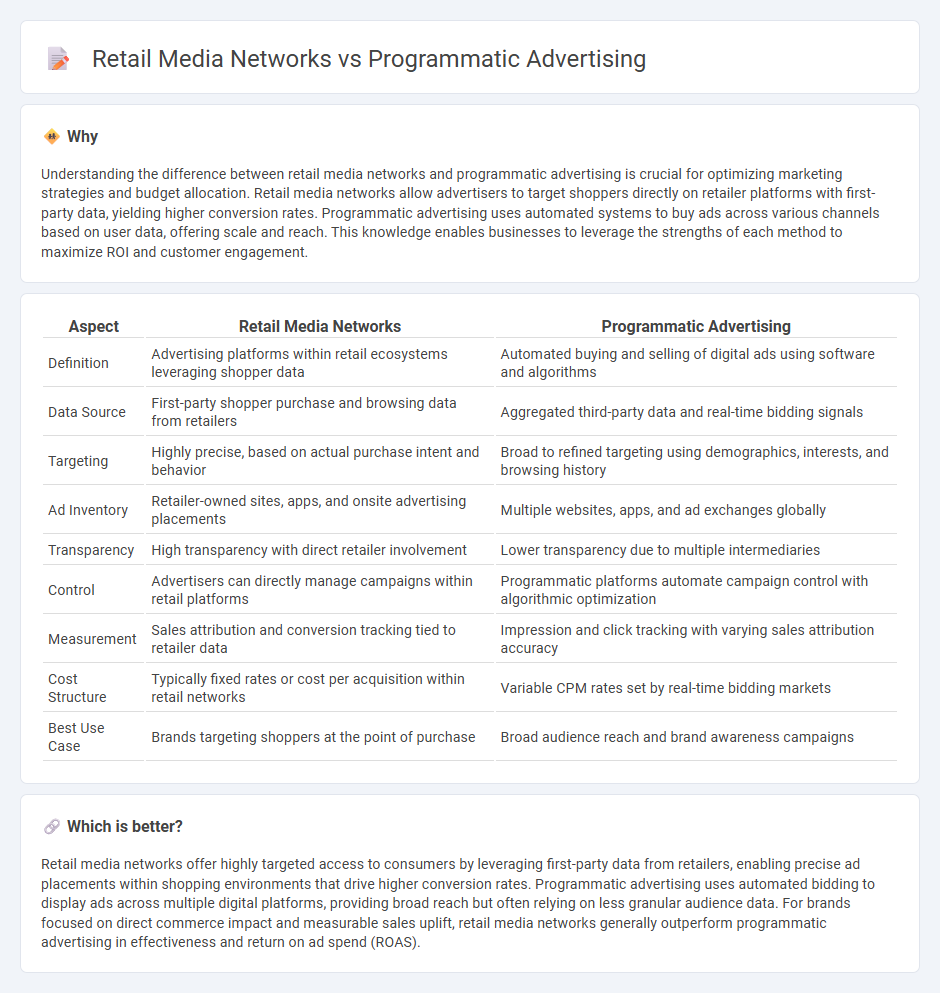
Retail media networks leverage first-party retail data to deliver targeted ads directly on retail platforms, driving higher conversion rates by reaching consumers at the point of purchase. Programmatic advertising uses automated technology to buy and sell digital ad space in real-time, optimizing campaigns across diverse channels for broad audience targeting and efficiency. Explore the distinct benefits and strategies of retail media networks versus programmatic advertising for enhanced commercial impact.
Why it is important
Understanding the difference between retail media networks and programmatic advertising is crucial for optimizing marketing strategies and budget allocation. Retail media networks allow advertisers to target shoppers directly on retailer platforms with first-party data, yielding higher conversion rates. Programmatic advertising uses automated systems to buy ads across various channels based on user data, offering scale and reach. This knowledge enables businesses to leverage the strengths of each method to maximize ROI and customer engagement.
Comparison Table
| Aspect | Retail Media Networks | Programmatic Advertising |
|---|---|---|
| Definition | Advertising platforms within retail ecosystems leveraging shopper data | Automated buying and selling of digital ads using software and algorithms |
| Data Source | First-party shopper purchase and browsing data from retailers | Aggregated third-party data and real-time bidding signals |
| Targeting | Highly precise, based on actual purchase intent and behavior | Broad to refined targeting using demographics, interests, and browsing history |
| Ad Inventory | Retailer-owned sites, apps, and onsite advertising placements | Multiple websites, apps, and ad exchanges globally |
| Transparency | High transparency with direct retailer involvement | Lower transparency due to multiple intermediaries |
| Control | Advertisers can directly manage campaigns within retail platforms | Programmatic platforms automate campaign control with algorithmic optimization |
| Measurement | Sales attribution and conversion tracking tied to retailer data | Impression and click tracking with varying sales attribution accuracy |
| Cost Structure | Typically fixed rates or cost per acquisition within retail networks | Variable CPM rates set by real-time bidding markets |
| Best Use Case | Brands targeting shoppers at the point of purchase | Broad audience reach and brand awareness campaigns |
Which is better?
Retail media networks offer highly targeted access to consumers by leveraging first-party data from retailers, enabling precise ad placements within shopping environments that drive higher conversion rates. Programmatic advertising uses automated bidding to display ads across multiple digital platforms, providing broad reach but often relying on less granular audience data. For brands focused on direct commerce impact and measurable sales uplift, retail media networks generally outperform programmatic advertising in effectiveness and return on ad spend (ROAS).
Connection
Retail media networks leverage consumer data from e-commerce platforms to deliver highly targeted ads, enhancing programmatic advertising's efficiency. Programmatic advertising automates ad buying using real-time bidding, which aligns seamlessly with retail media networks' access to precise shopper insights. This integration drives improved ad relevance, higher conversion rates, and maximized return on ad spend in the commerce sector.
Key Terms
Real-time Bidding (RTB)
Real-time Bidding (RTB) is a core technology in programmatic advertising, enabling automated, instantaneous auctions for ad space across diverse publisher sites, maximizing reach and targeting precision. Retail Media Networks leverage RTB within their proprietary ecosystems, allowing brands to bid on ad inventory directly on retailer platforms, enhancing shopper intent targeting and conversion rates. Explore how integrating RTB in retail media networks optimizes ad spend and drives measurable ROI.
First-party Data
Programmatic advertising and retail media networks both leverage first-party data to enhance targeting precision and campaign effectiveness, with retail media networks often relying on granular shopper insights collected directly through brand-owned channels. First-party data in retail media networks enables advertisers to deliver personalized offers and ads based on real-time purchase behavior and customer preferences, resulting in higher conversion rates. Explore how first-party data utilization differentiates these approaches and drives ROI in digital marketing strategies.
Walled Garden
Programmatic advertising leverages real-time bidding across open exchanges to target diverse audiences, while retail media networks operate within Walled Gardens that offer exclusive first-party shopper data from platforms like Amazon and Walmart. These Walled Gardens provide advertisers with highly precise audience segmentation and closed-loop attribution, optimizing ad performance directly linked to purchase behaviors. Explore how Walled Gardens in retail media networks reshape targeted advertising and drive measurable ROI.
Source and External Links
Programmatic Advertising - What It Is and How It Works - Programmatic advertising automates the buying and selling of digital ads using marketing technology, delivering targeted ads in real time through auctions across web, mobile, apps, video, and social media.
Programmatic advertising - The complete guide - Powered by AI and machine learning, programmatic advertising automates media buying, enabling advertisers to segment audiences and purchase ad impressions in real time through data-driven marketplaces.
What Is Programmatic Advertising? How Does It Work? - Programmatic advertising uses automated technology and algorithms to buy ad space, ensuring ads reach the right audiences at the right time without the need for manual negotiation.
 dowidth.com
dowidth.com